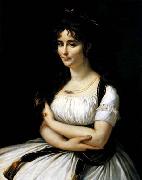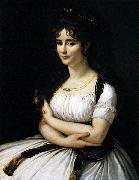
|
Baron Antoine-Jean Gros
|
|||
|
|
|||
| 1771-1835 French Baron Antoine-Jean Gros Galleries The son of a painter, Antoine Jean Gros was born in Paris on March 16, 1771. At the age of 14 he entered the studio of Jacques Louis David, the acknowledged leader of the classical revival. Although his own work became radically different from David's, he maintained a lifelong respect for his teacher and envisioned himself as the upholder of the Davidian tradition. In 1787 Gros entered the Acad??mie de Peinture, and when the Acad??mie dissolved in 1793 (a result of the French Revolution) he went to Italy. He met Josephine Bonaparte in Genoa in 1796, and she introduced him to Napoleonic society. Gros entered Napoleon's immediate entourage and accompanied him on several north Italian campaigns. Gros also became involved with Napoleon's program of confiscating Italian art for removal to France. Gros returned to Paris in 1800 and began to show his Napoleonic paintings in the annual Salons. The most famous of these are the Pesthouse at Jaffa (1804) and Napoleon at Eylau (1808). These works served to deify Napoleon, showing him engaged in acts of heroism and mercy. Stylistically, the paintings were revolutionary:their exotic settings, rich color, agitated space, and general penchant for showing the gruesome specifics of war and suffering differed radically from the cool generalizations of Davidian classicism that Gros had learned as a student. The presentation of contemporary historical events was also new, a harbinger of the realism that developed steadily during the first half of the 19th century in French, American, and English painting. Finally, the emphatic emotionalism of Gros's art established the foundation of romantic painting that Th??odore G??ricault and Eug??ne Delacroix developed after him. Unlike that of some of his countrymen (David is a case in point), Gros's position did not suffer after the fall of Napoleon. Gros painted for the restored monarchy, for instance, Louis XVIII Leaving the Tuileries (1817), and he decorated the dome of the Panth??on in Paris with scenes of French history (1814-1824). For this Charles X made him a baron in 1824. But these works lack the zest and commitment of Gros's Napoleonic period, perhaps because they were not based on the immediate kinds of historical experiences that had inspired the earlier paintings. Although marked by considerable public success, Gros's later career was in many ways acutely troubled. Basically, he could not resolve his personal esthetic theories with his own painting or with the work of his younger contemporaries. To the end Gros wished to propagate the classicism of David, and he took over David's studio when the master was exiled in 1816. By the 1820s, however, the revolutionary romanticism of G??ricault and Delacroix, among others, had clearly begun to eclipse classicism, and Gros found himself fighting a lonely and losing battle for conservatism. Ironically, he was fighting a trend that his own best work had helped to originate. As he persisted, moreover, his own painting began to show a diffident mixture of classic and romantic attitudes. Thus, while he was inherently a romantic, he tragically came to doubt himself. Gros died on June 26, 1835, apparently a suicide. | |||
|
|
|||
|
Madame Pasteur new16/Baron Antoine-Jean Gros-423626.jpg Painting ID:: 44070 |
1795-96 Oil on canvas, 86 x 67 cm | ||
|
|
|||
|
antoine jean gros
|
|||
|
|
|||
| Baron Antoine-Jean Gros (16 March 1771 ?C 25 June 1835), also known as Jean-Antoine Gros, was both a French History and neoclassical painter. Born in Paris, Gros began to learn to draw at the age of six from his father, who was a miniature painter, and showed himself as a gifted artist. Towards the close of 1785 Gros, by his own choice, entered the studio of Jacques-Louis David, which he frequented assiduously, continuing at the same time to follow the classes of the College Mazarin. Bataille d´Aboukir, 25 juillet 1799, 1806, (detail).The death of his father, whose circumstances had been embarrassed by the French Revolution, threw Gros, in 1791, upon his own resources. He now devoted himself wholly to his profession, and competed (unsuccessfully) in 1792 for the grand prix. About this time, however, on the recommendation of the École des Beaux Arts, he was employed on the execution of portraits of the members of the National Convention, and disturbed by the development of the Revolution, Gros left France in 1793 for Italy. | |||
|
|
|||
|
Madame Pasteur new24/antoine jean gros-677833.jpg Painting ID:: 81274 |
between 1795(1795) and 1796(1796) Medium Oil on canvas cyf | ||
|
|
|||
|
Also Buy::. For Following Paintings / Artists / Products, Please Use Our Search Online: |









